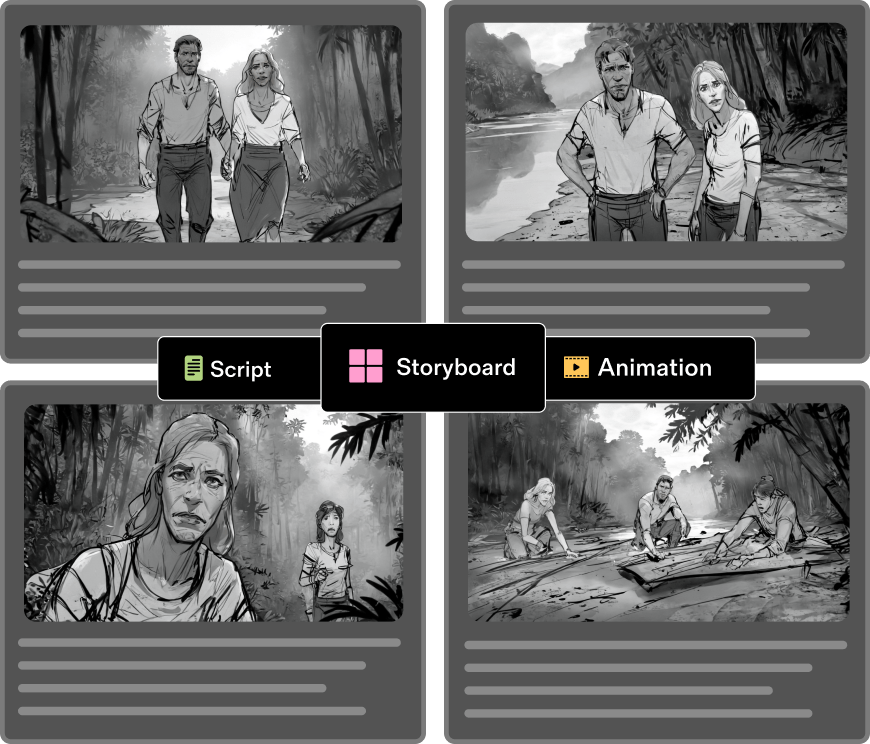An animation storyboard is a visual representation of a story, crucial in the pre-production phase of animation. It consists of a series of drawings or illustrations arranged in sequence to depict the key scenes and actions. Each frame or panel in the storyboard represents a specific moment in the narrative, providing a clear visual guide for animators and directors.



The main purpose of an animation storyboard is to map out the story's flow, scene timing, and character positioning. This helps everyone involved in the project understand the storyline and ensures a cohesive final product. By identifying potential issues early, storyboarding saves time and resources during the animation process, ensuring that the final animation is well-structured and engaging for the audience.

Directors use storyboards to visualize the narrative and ensure seamless story flow.

Animators rely on storyboards for understanding sequences and maintaining consistency in character movements.

Producers use storyboards to plan resources and keep the project on schedule and within budget.

Writers create storyboards to translate scripts into visual elements, ensuring their words unfold correctly on screen.

Editors use storyboards to plan cuts and transitions, enhancing the narrative flow.

Marketing and PR specialists use storyboards to create compelling promotional content for the animation project.
Early 20th Century
1930s
1940s-1950s
1960s-1970s
1980s-1990s
2000s-Present
Storyboarding remains a foundational element of the animation production process, continually evolving with technological advancements while maintaining its core purpose of visual storytelling.



.jpg)

Translating a written script into a visual format can be challenging. Storyboarding helps storyboard creators and the rest of the team see how scenes will unfold, making it easier to understand the narrative flow and the pacing of the story.

Ensuring that scenes have the correct timing and pacing is crucial in animation. Storyboards allow creators to map out the timing of each scene and adjust the pacing to maintain viewer engagement and convey the story effectively.

Maintaining continuity and consistency in character actions, settings, and overall visual style can be difficult. Storyboards provide a visual reference that helps keep these elements consistent throughout the production.

Conveying complex visual ideas and actions to a team can be challenging. Storyboards serve as a common visual language that all team members can understand, facilitating better communication and collaboration.

Potential problems with the narrative, shot composition, or scene transitions can be hard to spot in the script stage. Storyboarding allows creators to identify and address these issues early in the production process, saving time and resources.

Determining the best way to frame shots and compose scenes can be a challenge. Storyboards allow artists to experiment with different compositions and framing techniques before committing to final animations. Resource Allocation: Planning and allocating resources effectively is crucial in

Planning and allocating resources effectively is crucial in animation production. Storyboards help producers and directors visualize the scope of each scene, making it easier to allocate resources such as time, budget, and manpower efficiently.

Complex action sequences or intricate movements can be difficult to animate without a clear plan. Storyboards break down these sequences into manageable parts, providing a clear roadmap for animators to follow.

Getting approval from clients or stakeholders can be a lengthy process. Storyboards provide a visual representation of the project, making it easier for clients and stakeholders to understand the vision and provide feedback before the animation process begins.

Experimenting with different ideas and concepts can be risky and time-consuming. Storyboards allow creators to quickly sketch out and test various ideas, making it easier to explore creative options without investing significant time and resources.
By addressing these challenges, Katalist streamlines the animation production process enhances communication, ensures consistency, and ultimately contributes to the creation of a more polished and effective final product.
Get Started for Free

Get Started for Free







By following these steps, you can efficiently create detailed, professional storyboards that enhance your animation project, streamline your workflow, and foster creative collaboration.
Get Started for Free


Generate complete, professional-level scripts from a description or an idea. Say goodbye to writer’s block.

Import your scripts in various formats, including FDX, CSV, PDF, or DOCX. We’ve got you covered.

Automatically convert your scripts into detailed storyboards, saving time and ensuring accuracy.

Maintain continuity with automated tools that ensure consistent character designs and scene layouts.

Upload a single photo of a character, and Katalist will transform it into your main character with one click.

Collaborate in real-time with your team, sharing and editing storyboards seamlessly.

Control camera angles, shots, and poses to create a visual story that fits your ultimate vision.
Choose Katalist AI for your storyboarding needs and experience a new level of creativity, efficiency, and collaboration in your animation projects.
Get Started for Free